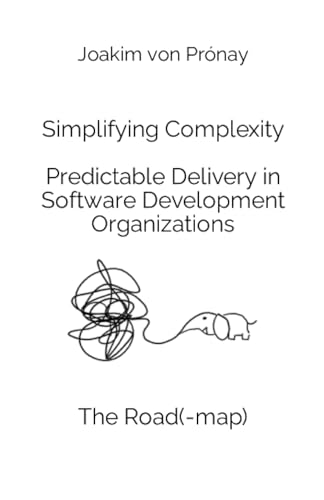Verwandte Artikel zu Simplifying Complexity - Predictable Delivery in Software...
Simplifying Complexity - Predictable Delivery in Software Development Organizations: The Road(-map) - Softcover

Inhaltsangabe
This book focuses on a concept to achieve predictable delivery in software development organizations based on a metaphor of a road together with the common phenomenon of traffic congestion.
How do you go from estimation-driven planning to data-driven forecasting in your software development process? That is not an easy question to give a concrete answer to as it depends heavily on the context and unique characteristics of the organization. To succeed and come up with workable solutions it is important to have a shared understanding of what you are trying to achieve and why. That is where this book comes in. It is a companion for a shared understanding and language about predictability in software development organizations to guide you in your quest to improve predictability.
Companies that are in different stages of their evolution have different goals and employ different strategies. Broadly speaking we can narrow it down to three categories.
- Start-up organization - where the goal is to find your product/market-fit, to confirm whether you have a solution to a problem worth solving for your potential customers. The time-horizon of interest can normally be described in days, or maybe weeks.
- Emerging organization - you have established your first product(s) and are in pursuit of increased profitability while growing the organization along with your business. Time-horizons of interest are usually discussed in months.
- Enterprise organization - a well-established product portfolio exists, and you have clear hierarchies with accountability along with rigorous processes to manage everything from day-to-day business to strategic planning. Strategic developments are often viewed in time-horizons of multiple years.
One of the recurring challenges is finding an answer to the question stemming from the executive management team – “when can this thing be done?” Any answer to the question based on estimates is subject to the planning fallacy, where individuals systematically underestimate the amount of time needed to perform a task. Plans that are then made based on erroneous estimates will create wrong expectations on what is plausible. This will in turn create a destructive loop where teams and individuals are held accountable for the estimates made instead of the actual deliveries with increasing pressure to provide more detailed estimates, which results in less accurate predictions, repeating the loop.
I will approach this question throughout the book from the perspective of an enterprise organization with the goal of making better strategic decisions. The concepts, principles and ideas can, however, be used by all size organizations knowing that the time-horizon for the desired effects will be different.
Die Inhaltsangabe kann sich auf eine andere Ausgabe dieses Titels beziehen.
EUR 45,00 für den Versand von Deutschland nach USA
Versandziele, Kosten & DauerSuchergebnisse für Simplifying Complexity - Predictable Delivery in Software...
Simplifying Complexity - Predictable Delivery in Software Development Organizations: The Road(-map)
Anbieter: medimops, Berlin, Deutschland
Zustand: very good. Gut/Very good: Buch bzw. Schutzumschlag mit wenigen Gebrauchsspuren an Einband, Schutzumschlag oder Seiten. / Describes a book or dust jacket that does show some signs of wear on either the binding, dust jacket or pages. Artikel-Nr. M0B0CHKZ4Z7Y-V
Anzahl: 1 verfügbar
